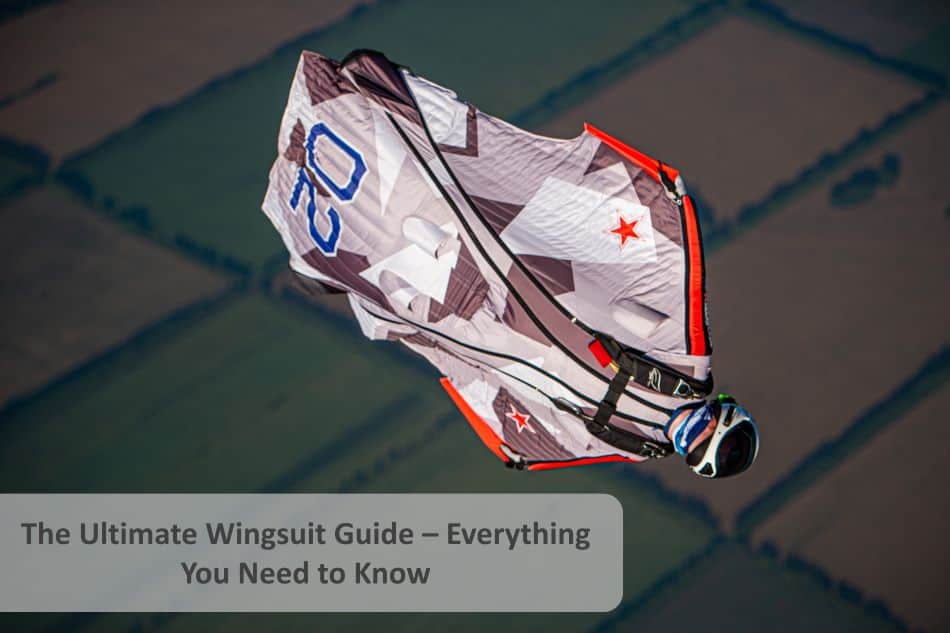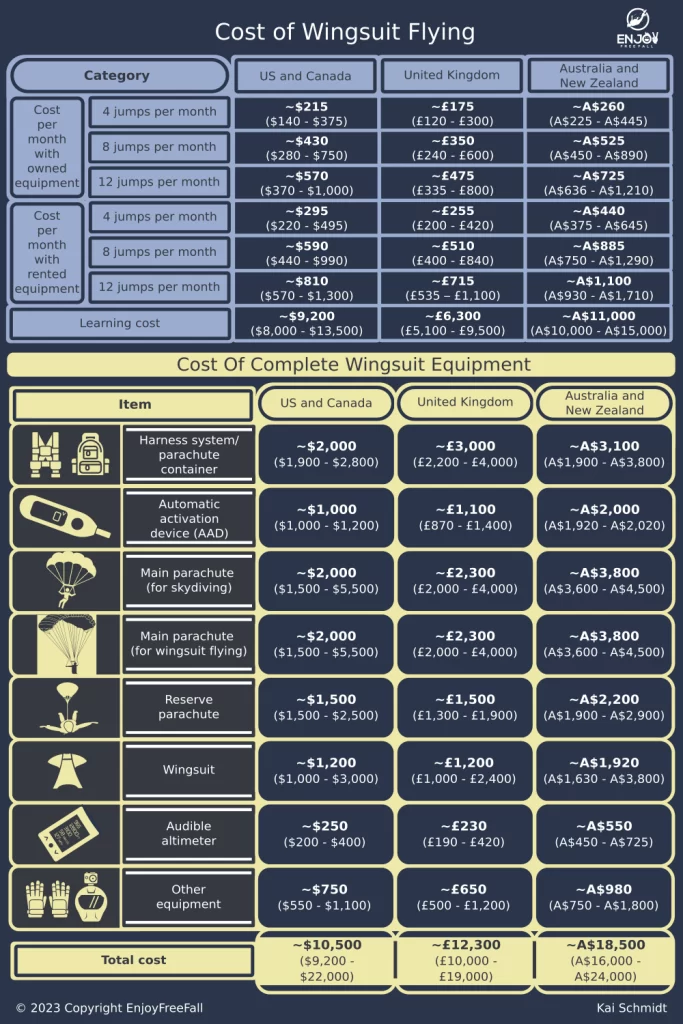
Have you ever been curious about the gravity-defying flights of extreme athletes in wingsuits? If yes, this guide offers a complete explanation of the sport and will help you evaluate the difficulty and risks of the sport. Regardless of whether you’re a seasoned wingsuit veteran or a curious newcomer, this ultimate guide is for you.
The following post is structured in a logical order, starting with an introduction to wingsuit flying, followed by the mechanics of how it works, the process of skydiving with a wingsuit, and finally addressing common questions and concerns.
What Is Wingsuit Flying?
Wingsuit flying is an extreme sport and a variation of skydiving, using a specially designed jumpsuit called a wingsuit. This suit features webbed extensions between the arms and the legs, augmenting the diver’s surface area, enabling increased lift, and facilitating extended gliding flight.
Unlike conventional freefalling, wingsuit flyers engage in a distinctive form of descent, showcasing a remarkable fusion of aerodynamics and adrenaline-fueled adventure.
How Does Wingsuit Flying Work?
Due to the extensions between the arms and legs, the wingsuit increases the diver’s surface area against the air and wind. As a result, the gravitational pull from Earth is counteracted, allowing the wingsuit pilot to cover horizontal distance rather than falling vertically toward Earth.
If you are interested to learn more about the relationship between air resistance and gravitational pull, make sure to check out my article about the distance and time to reach terminal velocity in skydiving. It explains everything about the underlying physical forces and how to manipulate them.
Is Wingsuit Flying an Extreme Sport?
As a whole, wingsuit flying is an extreme sport due to the extreme physical and mental demands it places on athletes. Wingsuit fliers have to process and handle many factors at the same time such as winds, surrounding terrain, and their own body movements while facing inherent dangers.
In order to survive and excel in the sport, wingsuit fliers need to have quick reaction times and need to make the right decisions at the right time. For instance, in case of parachute problems they need to either resolve the issue in a matter of seconds or cut their main parachute loose to be able to deploy their reserve parachute.
As a result, wingsuit fliers are highly trained individuals, that have extensive skydiving experience. If you want to learn more about the reasons why wingsuit flying is so difficult, check out my article about how difficult wingsuit flying really is. Afterward, you will know why wingsuit flying is seen as one of the supreme sports in the world!
How Do You Skydive With a Wingsuit?
Wingsuiting involves the same equipment and practices as skydiving except for parachute deployment. Before deployment, wingsuiters need to reduce their forward speed by bringing their body into a vertical (45°) position. They also unzip their arms after the deployment to be able to steer the canopy.
In addition to these operational aspects, disparities between wingsuit flying and skydiving encompass factors such as velocity and duration of flight. For a comprehensive exploration of these distinctions, I recommend delving into my article elaborating on the 11 stunning differences between wingsuit flying and normal skydiving.
In the following section, I delve into the different parts of the jumps and address the mechanics, common questions, and most important parts of it.
How Does the Jump-Off in Wingsuit Flying Work?
Once wingsuit flyers initiate a jump from an aircraft or a base, they promptly enter a state of freefall. During this phase, extending their arms and legs facilitates the formation of wings. With their spine, arms, and legs aligned, the wingsuit flyers attain command over their flight trajectory.
Where Can Wingsuit Flyers Jump From?
As a general rule, wingsuit flyers can jump either from airplanes, akin to normal skydiving, or from BASE jumping locations. BASE jumping exit points encompass structures such as buildings, antennas, bridges, and elevated cliffs, all providing sufficient height for proper parachute inflation.
How Low Can You Jump With a Wingsuit?
The lowest height that wingsuit fliers can jump from is around 2,000ft (610m) to generate enough airspeed to keep their wingsuit inflated. However, as a wingsuit creates a forward motion, the object does not need to be exactly 2,000ft high but can rather offer terrain that slopes downward as well.
When jumping from 2,000ft (610m), wingsuit flyers should deploy their at 450ft (137m) to give enough time for the parachute to inflate and break properly. It also gives them some slack to resolve issues during the deployment process. The lowest recorded height for a base jumping opening is 95ft (29m).
If you want to learn more about the lowest possible height to deploy a parachute during skydiving, base jumping, and military jumps, make sure to check out my guide about the minimum altitude to open a parachute. It also includes the lowest opening ever performed!
The Wingsuit Flight Explained
The wingsuit flight is one of the most iconic and liberating experiences that skydivers can encounter. After the exit or jump-off, wingsuit flyers spread their arms and legs to increase the surface of their wingsuit and generate the air resistance that allows wingsuit pilots to fly.
During the flight, wingsuit pilots need to understand how to adjust their bodies to control their glide, altitude, and direction. This includes learning how to stabilize, turn, and eventually perform more advanced maneuvers, for which body control is essential.
Wingsuit flyers also need to closely monitor the weather such as the wind speed and direction – as they can impact the flight as well.
How Do You Control a Wingsuit?
Wingsuit divers control their flight path by manipulating the surface of their wingsuit in response to air resistance. For example, to execute a right turn, a wingsuit pilot will tilt their body to the right, causing an enlargement of the surface area perpendicular to the flight direction.
It is important during this maneuver that wingsuit flyers keep the tension in their body and their wings. Otherwise, the wingsuit would deflate and change the surface area drastically. Experienced wingsuit pilots can also adjust the surface area between their arms to change their body position.
How Do Wingsuit Jumpers Control Their Velocity?
To control their speed, wingsuiters adjust the angle of their wingsuit relative to their flight direction. They decrease their speed by extending the surface area perpendicular to their flight direction, and conversely, they accelerate by reducing the area perpendicular to their flight direction.
Harnessing the aerodynamic force generated by drag, they are also capable of governing both their flight direction and the distance they cover. To learn more about this, check out my article about how far wingsuit pilots can fly.
How Many Mph Is a Wingsuit?
On average, wingsuits attain a forward speed of approximately 100 mph, corresponding to a downward descent speed of roughly 32 mph and a horizontal travel rate of 95 mph. Experienced wingsuit flyers can achieve significantly higher speeds exemplified by the highest recorded speed of 249 mph.
If you want to learn more about the wingsuit speed and the highest recorded jump, make sure to read my article about how fast wingsuits can go. it includes an in-depth analysis of the factors to manipulate the forward speed.
Does Wingsuiting Feel Like Flying?
Wingsuit flying provides a sensation similar to flying and is as close as humans can come to experiencing bird-like flight, specifically when terminal velocity is reached. While wingsuits capture the gliding aspect of bird flight, certain bird-specific movements like flapping cannot be reproduced.
Do You Still Need a Parachute With a Wingsuit?
It is essential to use a primary and a reserve parachute in wingsuit flying as wingsuits do not offer enough surface to reduce the speed enough for a safe landing. The parachutes are, therefore, indispensable as they ensure that the right speed for safe landings is reached.
That being said, there has been one instance where a wingsuit pilot accomplished a landing without utilizing a parachute. If you want to learn more about it, check out my article about the 13 most mind-blowing wingsuit stunts ever performed.
The Parachute Deployment Process of Wingsuiters Explained
Wingsuit parachute deployment differs slightly from standard skydiving deployment. Unlike traditional skydiving with regular suits, wingsuit flyers maintain forward motion during their flight. Consequently, the angle of the parachute in relation to the Earth is also different. If a wingsuit flyer were to deploy the parachute using the conventional skydiving method, there is a possibility that the parachute might not inflate properly.
In short, the wingsuit deployment involves several key factors: maintaining the right altitude, controlling airspeed through flaring to achieve proper pitch, and ensuring a symmetrical body position. So how does that look in practice?
How Do You Deploy a Wingsuit?
By initiating a controlled flare, wingsuit flyers slow down their descent and establish the correct pitch attitude for deployment. During deployment, maintaining symmetry and utilizing riser control help prevent complications like line twists and ensure a successful parachute opening.
After the deployment, the wingsuit pilots unzip their arms to be able to grab the steering toggle. The canopy flight is then similar to traditional skydiving – it might just be a little bit shorter due to the lower deployment height of wingsuit pilots.
There is also a common belief that parachutes ascend during deployment. If this notion intrigues you, you can explore the topic further by reading my article on whether parachutes go up when opened.
The Landing Process of Wingsuit Flights Explained
The landing is the most important and most dangerous part of any skydive or wingsuit flight. The landing in a wingsuit is the same as in a traditional suit, just with the difference that the wingsuit is more bulky to wear. There are two landing techniques: a seated or standing posture upon landing.
The seated or slide-in position finds popularity among novices and tandem skydivers due to its safety advantages, reducing the risk of injury. To execute this landing approach, wingsuit pilots raise their legs in front, pointing their toes skyward as they approach the ground. Consequently, they touch down on their posterior.
In contrast, landing in a standing position involves the wingsuit pilot alighting on their feet and maintaining an upright stance. This method is favored by seasoned wingsuit pilots, solo skydivers, and occasionally tandem jumpers.
If you want to learn more about landing and the most incredible wingsuit landings ever performed, make sure to read my article about how wingsuit flyers land.
The Planning Process of Wingsuit Flights
Planning is paramount in wingsuit flying due to its inherent risks and complexities. Adequate planning helps mitigate potential dangers, account for weather conditions, and ensure a safe and successful flight. While planning a wingsuit flight from an aircraft is similar to the planning procedure of normal skydiving, planning wingsuit base jumps is different.
In base wingsuit flying, important elements such as choosing a safe exit point, plotting a suitable flight path, managing altitude for parachute deployment, identifying a proper landing area, and preparing for emergencies are paramount. Creating visual aids, like sketches, can aid in understanding jump parameters.
Even when addressing these aspects, wingsuit flying is still dangerous, especially if done in combination with base jumping. If you want to learn everything about the safety of the sport, make sure to read my guide about how dangerous wingsuit flying really is.
Common Questions and Concerns About Wingsuit Flying
Are Wingsuits Legal?
Wingsuit flying is legal when conducted within designated areas and when the divers have successfully completed proper wingsuit training and acquired the skydiving C-license. Wingsuit flying without the required license or in restricted zones, such as National Parks, is not permitted by law.
How Much Does a Wingsuit Cost?
On average, a new wingsuit costs around $1,200, thereby representing a significant investment. Depending on the brand and functionality, the cost lies between $1,000 and $3,000 dollars. Renting a wingsuit costs between $200 and $300 per month or between $20 and $30 per jump.
If you want to learn about strategies to save money, when buying wingsuit equipment make sure to check out my article about how much wingsuit flying costs. Reading it will save you thousands of dollars!
What Angle Does a Wingsuit Fly At?
On average, wingsuit fliers have a glide ratio of 3:1 which corresponds to a flying angle of ~18.5°. The glide ratio explains how much the wingsuit pilot moves forward with each foot of descent. Experienced wingsuit pilots can even achieve a glide ratio of 5:1, corresponding to an angle of ~11.3°.
Do Wingsuits Actually Work?
Wingsuits actually work and fulfill the intended function of forward gliding. Wingsuits resemble birds gliding through the air but do not enable upward flight like planes. To safely land after a wingsuit flight, a parachute is still necessary to control the descent and ensure a safe landing.
How Do Wingsuits Generate Lift?
A wingsuit generates lift by increasing the skydiver’s surface area, which increases the wind resistance or drag during freefall. Many wingsuits have vents that let air in, inflating the suit into a semi-rigid wing, creating even more lift, similar to how a parachute works.
How Do Wingsuits Not Crash?
Wingsuit pilots avoid crashing through the increased lift that the wingsuit generates, enabling forward motion during descent. Wingsuit flyers also select terrains with downward slopes that provide vertical descent space, preventing abrupt crashes.
Even though it might look differently at videos, especially POV videos, wingsuit flyers are falling downwards. Due to the forward speed, however, they can fly along steep, downward-sloping terrain, making it often look like they were flying rather than just falling.
What Are the Disadvantages of Wingsuit Flying?
Wingsuit flying has its drawbacks, including safety risks like collisions and parachute issues, along with the high costs associated with learning and equipment. Additionally, wingsuit flying can take an emotional toll on loved ones, lead to adrenaline addiction, and is subject to legal constraints.
Let me explain quickly, what impact these drawbacks can have on your life.
- Safety Risks: Wingsuit flying comes with inherent risks, including the potential for collisions, parachute malfunctions, and challenges during landing.
- Financial Cost: Learning wingsuit flying involves substantial expenses, including training, specialized equipment, and ongoing costs for regular practice. If you want to learn more about the cost, check out my complete cost guide to wingsuit flying.
- Emotional Burden: Friends and family might experience constant worry due to the dangers associated with wingsuit flying.
- Legality Issues: While there are excellent dropzones for wingsuit flying, it’s important to note that base wingsuit flying is often illegal due to safety concerns.
- Addictive Nature: The adrenaline rush and excitement of wingsuit flying can lead to addiction, which might impact one’s lifestyle and priorities.
How Many Wingsuiters Are There?
There are approximately 11,000 wingsuit pilots worldwide and 6,000 wingsuit pilots in the USA. As such wingsuit flying remains a niche sport with only a few athletes that engage in the activity. With the recent awareness, it can be assumed that the numbers will be growing strongly.
If you got curious and would love to start wingsuit flying, make sure to check out my article about how to learn wingsuit flying. It includes a step-by-step guide and ensures that you will realize your dream of flying as soon as possible.
If you are not yet convinced, you might opt for doing a tandem wingsuit jump, an indoor wingsuit flight, or a wingsuit simulation. But make sure that you meet the weight requirements for wingsuits beforehand.
That being said, enjoy your free fall!
Foto Credits
Featured image: PaulaBerenguer, CC BY-SA 4.0 https://creativecommons.org/licenses/by-sa/4.0, via Wikimedia Commons, resized and cropped
Gallery image: Gsmcenter, CC BY-SA 4.0 https://creativecommons.org/licenses/by-sa/4.0, via Wikimedia Commons, resized, writing added




